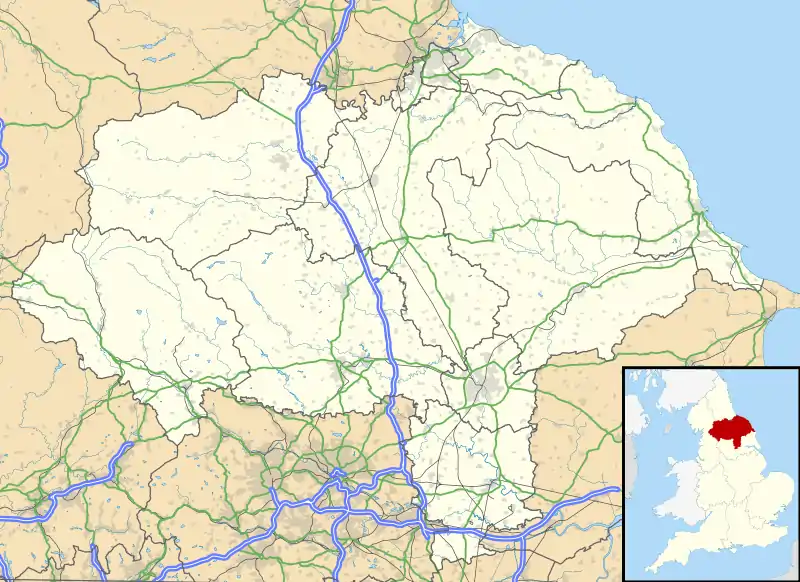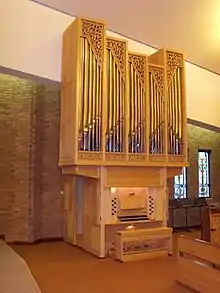Middlesbrough Cathedral
Saint Mary's Cathedral, also known as Middlesbrough Cathedral, is a Roman Catholic cathedral in Coulby Newham, Middlesbrough, England. It is the see of the Bishop of Middlesbrough, who is ordinary of the Diocese of Middlesbrough in the Province of Liverpool.[1]
| Saint Mary's Cathedral, Middlesbrough | |
|---|---|
| Cathedral Church of Saint Mary | |
 | |
 Saint Mary's Cathedral, Middlesbrough Shown within North Yorkshire | |
| 54.5227°N 1.2137°W | |
| OS grid reference | NZ509144 |
| Location | Middlesbrough |
| Country | England |
| Denomination | Roman Catholic |
| Website | middlesbroughrccathedral.org |
| History | |
| Status | Active |
| Dedication | Saint Mary the Virgin |
| Consecrated | 1998 |
| Architecture | |
| Functional status | Cathedral |
| Previous cathedrals | Cathedral of Our Lady of Perpetual Succour, Sussex Street |
| Architect(s) | Frank Swainston |
| Groundbreaking | 3 November 1985 |
| Administration | |
| Diocese | Middlesbrough |
| Province | Liverpool |
| Clergy | |
| Bishop(s) | Terence Patrick Drainey |
| Dean | Mgr Gerard Paul Robinson |
| Laity | |
| Director of music | Timothy Craig Harrison |
History
The original Cathedral Church of Our Lady Of Perpetual Succour was built from 1876 and was opened on 21 August 1878. It was situated on Sussex Street, in the old St. Hilda's district of Middlesbrough.[2] At the time, the church was located within the Diocese of Beverley as the diocese of Middlesbrough did not exist until December 1878. It was initially built not as a cathedral, but as a church that could hold 1,500 people to serve the people of Middlesbrough.[3]
The first bishop of Middlesbrough, Richard Lacy was consecrated there on 18 December 1879.
In August 1984, news reports stated that the cathedral had structural problems and may have to be pulled down. As it was a Grade II listed building, any demolition was officially blocked.[3] The shifting population of the town at the time also meant the cathedral had become more and more isolated. A new cathedral building was therefore required to replace the original. The new Saint Mary's Cathedral was built in the suburb of Coulby Newham, in the south of Middlesbrough, with building work commencing in November 1985.
The old cathedral was gutted by fire in May 2000.[4] The fire was supposedly started by a group of children playing inside the building, which was by then already in a significant state of disrepair.[3] Due to the extensive fire damage and risk of further collapse, the building was demolished soon after. The site is now the location of the Middlesbrough headquarters of Cleveland Police.[5]
Saint Mary's Cathedral
The original architect of the new cathedral at Coulby Newham was Frank Swainston, who died just after the outline plan had been agreed upon. His assistant Peter Fenton developed the detailed drawings and designed the cathedral furnishings. All this he brought to completion with the advice of J.O. Tarren and Professor Patrik Nuttgens.[6]
The foundation stone was blessed on Sunday 3 November 1985 by Augustine Harris, Bishop of Middlesbrough, who went on to consecrate it in 1998.
The cathedral is a modern, light building similar in some ways to the Roman Catholic cathedral in Liverpool. The building complex includes the sanctuary, the nave, the Blessed Sacrament chapel, the sacristy, the church hall, the narthex (the entrance porch) and the campanile.[7] There is also a repository where devotional aids, rosary beads, cards, and the like may be purchased. It was built to match the liturgical changes decreed by the Second Vatican Council. The council asked that all new churches should have an altar that is clearly visible to all and a liturgy that is audible to all.
Music
Cathedral Organ

Dr John Rowntree of the Organ Advisory Group (Society of St. Gregory), as consultant, established the requirements and design of the organ which was built by the firm of Schumacher of Europe in Belgium. The organ has two manuals and pedals, mechanical key and stop action and 16 stops. The case is of ash, in keeping with the furnishings of the cathedral , and its asymmetric form relates to its location off the central axis of the buildings and to the internal roof lines.
The stop list of the Organ is available here1
Cathedral Choral Foundation
The music tradition of the Cathedral is encompassed by the Cathedrals Choral Foundation, led by the Cathedral and Diocesan Director of Music. Choirs which are part of the Choral Foundation include:
- Cathedral Choir
- Cathedral Consort - (Directed by the Assistant Director)
- Lower Voices Schola Cantorum
- Ladies Schola Cantorum
- Diocesan Choir
Choral Service Pattern
Currently the Cathedral Choir sings for the main Sunday morning Solemn Mass. Choral Vespers are sung on two Sundays a month, on a second Sunday sung by the Cathedral Consort and on the forth Sunday by the Senior Girl Trebles. Choral Vespers and Benediction are also sung Choral Services on a Wednesday evening and these are led by the various other Choirs that make up the Choral Foundation of the Cathedral Music Department.
Other services at the Cathedral are also sung, however they are led by an Organist and/or Cantor.
Director of Music
Timothy Craig Harrison (2010–Present)
Assistant Organists
Julia Dowson, Dermot Ruddy, Graeme Drewery.
Choral Scholars
The first Choral Scholars were appointed in September 2017, they sing with both the Cathedral Choir and Cathedral Consort.
Soprano Choral Scholar
Grace Oliver (September 2017 – July 2019)
Hannah Perkin (September 2019 -)
Tenor Choral Scholar
Patrick Graham (September 2017 – July 2019)
References
- Diocese of Middlesbrough: St Mary's Cathedral
- "Our first Cathedral". Saint Mary's Cathedral. Retrieved 5 April 2015.
- Remember When, gazettelive.co.uk
- "Our First Cathedral". Middlesbrough Diocese Website. Retrieved 16 June 2017.
- "Middlesbrough District HQ". Cleveland Police. Retrieved 6 April 2015.
- "Cathedral Church of St Mary the Virgin". cbcew.org.uk. Retrieved 11 January 2020.
- "Saint Mary's Cathedral". Saint Mary's Cathedral. Retrieved 5 April 2015.
1. NPOR Website - http://npor.org.uk/NPORView.html?RI=N09155, accessed on September 5, 2018.
